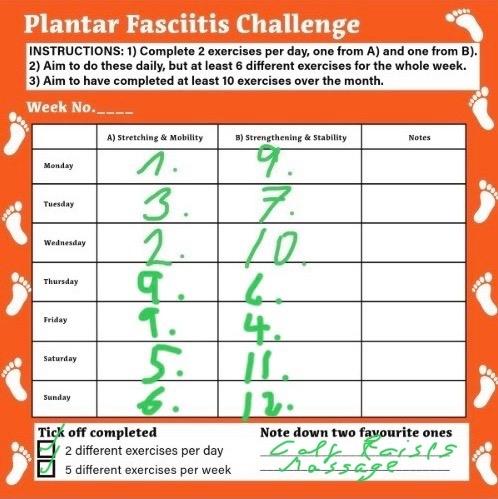Well, it took me 12 days to finish the Plantar Fasciitis Prevention Challenge (healthunlocked.com/strength... but my tiny PF niggles are disappearing, almost gone!
I never had a severe pain, just at times a slight ache in the mornings at the telling locations on my foot. So I suspected if I didn’t do anything to strengthen my arches, it might grow to something more severe.
So I started to look into the science of PF, read a few of the newest scientific papers, listened to podcasts and committed to starting some particular strengthening exercises.
And when a couple of forum friends came down with PF, I put together this PF Prevention challenge.
What I’ve learned from this journey and from comments of posters is that although one solution doesn’t fit all, there are many little things we can embed into our regular patterns of our running lives that are likely to help ease the PF pain.
What worked best for me are - I think - the following, in order of my perception of positive impact.
But there needs to be this caveat: These worked for me, someone with tight calves, a relative good exercise load of 60min average per day, but carrying some weight, doing only low impact and being a very slow runner and not getting enough walking in. So what worked for me, as set out below, not necessarily will work for anyone, and that’s of course is where trying out different stretches as set out in the PF prevention challenge, or getting the help from a specialist to figure out best exercises, can really help.
Having said all this, these things helped me were:
1. FOOT HEEL MASSAGE : I had started with massaging my feet after each shower, doing what they call deep, little windshield wipers. But I think what was a game changer is to massage my heel as well as the balls of my feet in a way that would break up any fascia tensions beneath the hard skin. Video below. This is in my mind the key change I made when noticing a distinct lessening of aches. Before, I had avoided massaging heel or balls of the feet.
2. ROLLING LOWER CALVES : I regularly roll my calves after rowing, which is ca 5 times a week. But 2 things about the roller session made the difference in my mind. a) I focus particularly on the lower part of the calves rolling all around the sides as well. From the painfully tight spots whilst rolling I realised at that time that I may not have rolled low enough to relief some fascia tensions in the lower part of my calves, possibly not giving me sufficient release and keeping my calves too tight. b) I also started using a longer roller to roll my upper back. I’m not sure this is related to PF, but I certainly get more tension release in my back now, and knowing the posterior chain is all connected, it all may help. These two rolling movements are in my case easily integratable into every post-row stretch routine.
3. CALF RAISES WITH TOES UP: I've done calf raises before, but the trick to do them with toes bent upwards (using a rolled up towel) was new. The towel now lives in front of my wardrobe, and before getting dressed daily, I’ll put in a few calf raises with toes on the towel. Very easy to integrate daily.
4. POST-RUN CALF STRETCH WITH CROSSED LEGS: During my looking into effective stretches, I found the advice of tweaking the classic standing calf stretch to include crossing front leg in front of the other. I’m not exactly sure what it does, but the stretch in the back leg goes deeper into the calves and may also include a different group of deeper set of calf muscles. Not quite sure how it contributes, but it feels good and is easily added to the standing calf stretch I already do after each run.
5. ALL SORTS: and then there are the multitude of all sorts of adapting positions and opportune movement snacks; a) I love sitting cross legged on floors, beds and couches and I often now make sure that some of the time I keep my toes flexed against my other leg; b) in the morning I do some ankle circles to wake up my calves; c) whilst brushing teeth, I do some calf raises; d) when moving about the house, I often now go on tiptoes.
Videos with demos:
1. FOOT HEEL MASSAGE (Video by Rebel Massage)
youtu.be/PDa_bXscXWE?si=Rz7...
2. ROLLING LOWER CALVES (Video by Caroline Jordan)
youtu.be/21aObP8kHvk?si=8i1...
3. CALF RAISES WITH TOES UP (Video by Spectrum Performance)
youtu.be/rxz8pddpdqE?si=Zmt...
4. POST-RUN CALF STETCH WITH CROSSED LEGS Video by Athlean-X)
youtu.be/NE0GqcRb9f8?si=NKd...
